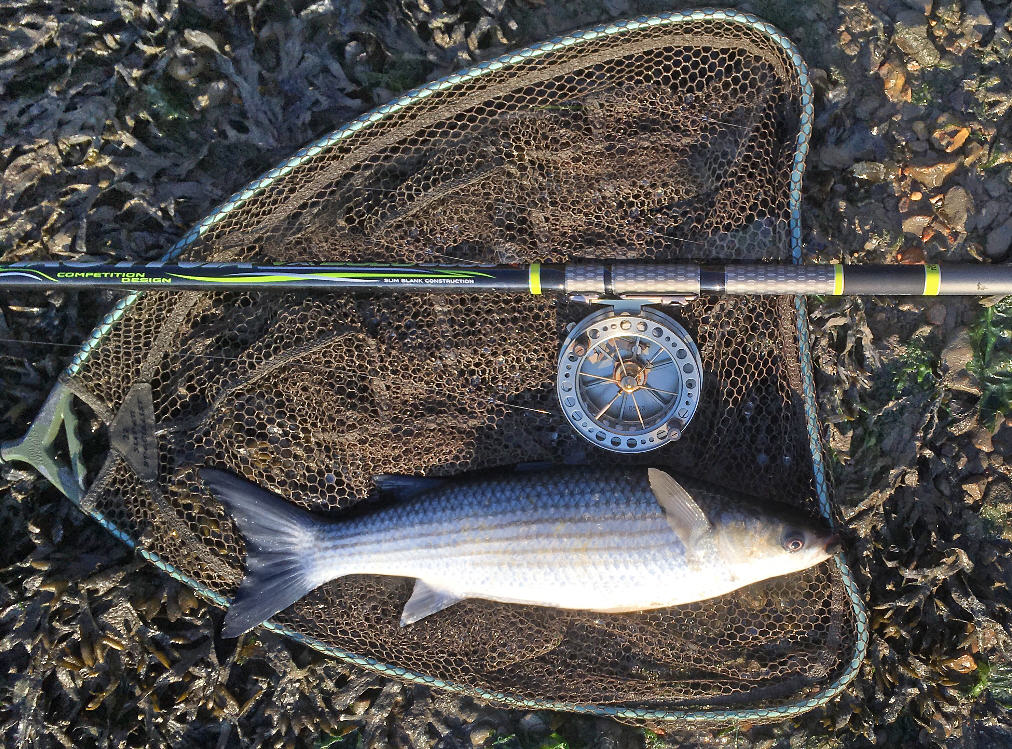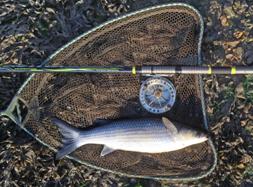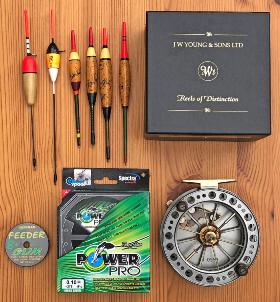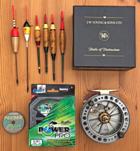|
Home Trotting & Feeding |
Long Trotting
|

|
|
Most people who know me and watch me fishing will normally find me up to my waist in either the Hamble, Adur or the Arun, trotting for mullet. Having come from a coarse fishing background, this was always my favourite method of catching fish, rather than fishing on featureless carp pools or lakes where every fish is known by name. I wrote an article a few years back that appeared on the NMC website, "Trotting and Feeding on the Lower Adur"; this is a sort of update on how my trotting, or to be more precise, my long-trotting has evolved in the last few years. On a lot of the venues I fish, long-trotting is a distinct advantage, but as most people who fish flowing waters know, the further you trot, the harder it is to hook a mullet. 13ft rods are fine for medium distances, but once you start trotting over 15 to 20 metres, bites become harder to hit and get a good hook hold; basically, you start to suffer more hook pulls and missed bites. Longer rods increase the amount of line you can pick up and give better hooking ratios and less missed bites. I've found 15ft to be a good length, light enough to hold for a long time, even the cheaper rods. I have tried 17ft rods, but unless you buy an expensive rod or have arms like Arnie, they are too heavy to hold for long periods of time, especially in adverse weather conditions. This extra length certainly increases the amount of hook ups, with less hooks pulling out, and also makes mending the line a lot easier, but this does not completely resolve the hooked-fish-to-bite ratio. A good friend of mine and my brother's, Paul Frid, was using light braid to long-trot for grayling, with my brother Alan; we decided that with the right combination of breaking strains of braid and mono this might work for mullet. We have been experimenting with floating braid for the past 3 seasons using 12 - 15lb Power Pro braid in a moss green colour; any breaking strain less than this is too light to mend the line at distance, also the 12 - 15lb breaking strains are more robust against any snags you may encounter. The main problem with braid is it has no stretch - great for line pick up, no good as a shock absorber with a big fish making sudden runs close in. To overcome this, we have added a short 8lb Power Gum shock absorber (5 inches long) on 2 micro swivels between the braid and the hook link, as most of our trotting is done in 3 - 5ft of water, so the hook link is around 2 - 3ft long and about 5lb breaking strain. This means that the braid and the hook link are pretty much the same diameter, which apart from the short length of power gum, makes the whole setup well balanced. The power gum is stretchy without being like an elastic band, just enough give in it to stop the lunges of a mullet close in from pulling the hook out. The only reel I use with this setup on is the trusty centre pin; I've tried it on a closed-face reel and it just doesn't have the same level of control over the speed of the trot that you get with a 'pin. If a fish makes a sudden run or tries to get in a snag, you can give line instantly or lock the 'pin down tight, which I'm sure gives you an edge when playing a mullet. I normally use a cork bodied Avon-type float, 3 - 5 swan (the larger the float the better the control and bait presentation - just make sure you have it shotted down low, and not like a lighthouse sticking out of the water). You will need at least 3 - 4 float rubbers which are quite tight fitting, as braid is more slippery than mono. Below the float, I use a short length of very fine silicone tubing to put my main bulk shot on; this protects the braid from the edges of the shot. When trotting, it is better to have 8AA shot rather than 4 swan shot as your bulk - this gives a lot better presentation - then I have the power gum link, and on the hook link I have 2 - 3 small shot (make sure these are put on lightly so you do not damage the hook link), finished off with the hook of your choice. The main advantages we have found with this setup when long-trotting with a 15ft or longer rod is that the hooked-fish-to-bite ratio improves dramatically; on some days, I have hooked 100% of bites at long range, landing the fish (3 mullet in 3 trots on the Hamble, 6 mullet on the day, not bad for a cold early April session). Braid doesn't seem to get caught in the current the same as mono, needing less mending, which is just a very light lift and flick of the rod tip. Sometimes the breeze catches the braid as you mend the line, and you just need to roll it to one side, often without even moving the float. Holding the float back with braid is just the lightest of touches on the rim of the centre pin, and when you get a bite, it's more of a quick lift, rather than a forceful strike that sends the float flying through the air. Once hooked, you feel every head-shake and run as though the fish was physically attached to your arm. In early and late-season sessions when bites can be at a premium, using braid has put mullet on the bank when I feel that normal mono would have just left me with missed bites. This setup was fully tested at Christchurch when I landed an 11lb carp on a strong ebbing tide; this fish made some 40 yard runs and was netted after 40 minutes. Closer to home, I also landed a 6lb 1oz mullet on the Arun - again, this fish fighting hard on a strong ebbing tide.
I hope this gives you an insight into some of the advancements my mullet fishing has had over the past few seasons and inspires you to try a different method of trotting. Mark Stinton Footnote: Mark Stinton is undoubtedly one of the most capable NMC mullet anglers, with an impressive catch rate, frequently succeeding in conditions where others struggle. He is a prolific writer for the NMC 'Grey Ghost' magazine, and since 2020, has occupied the role of NMC Fish-In Co-ordinator, generously passing on his considerable knowledge to those who attend the organised events around the country. |
|
| Last updated 29.03.22 |




